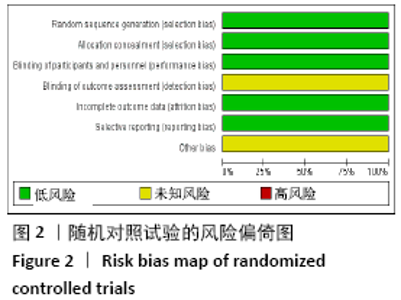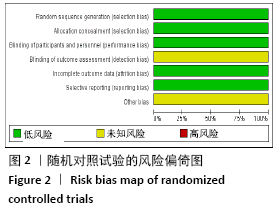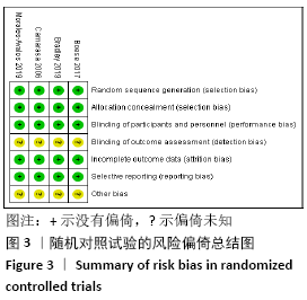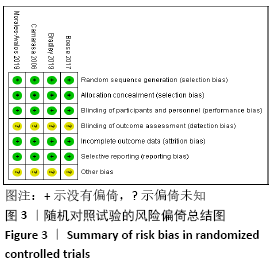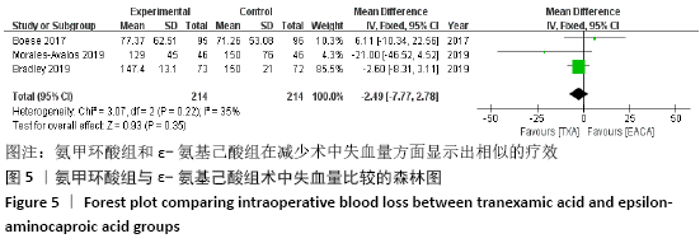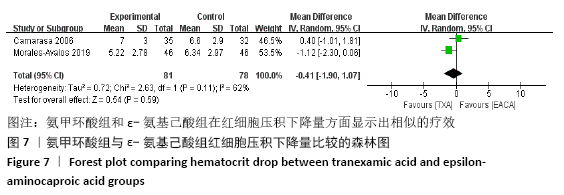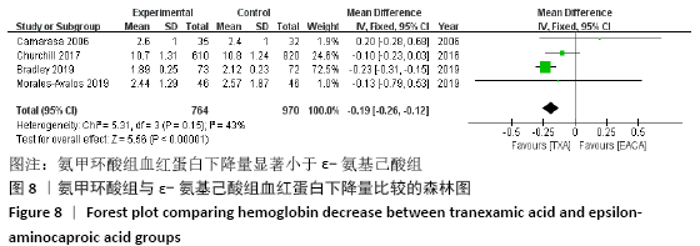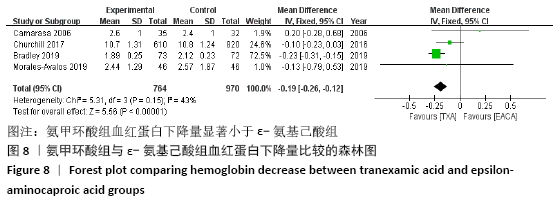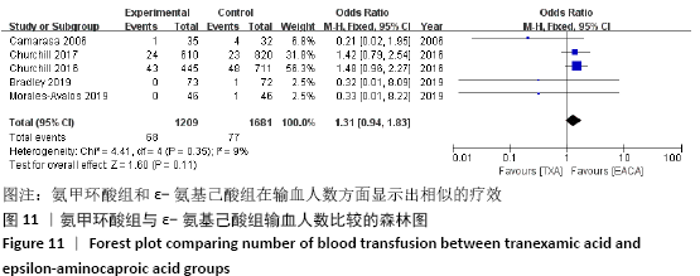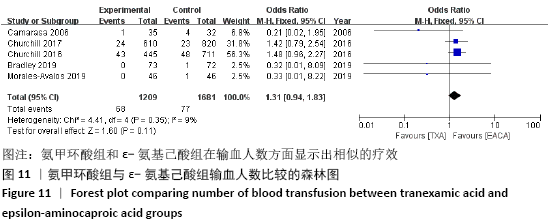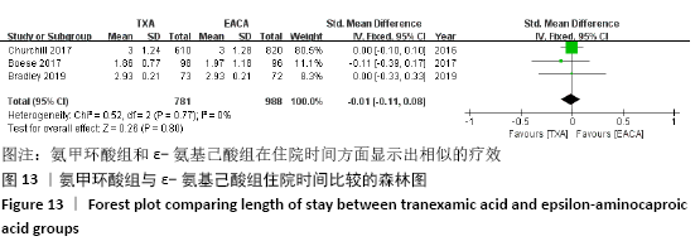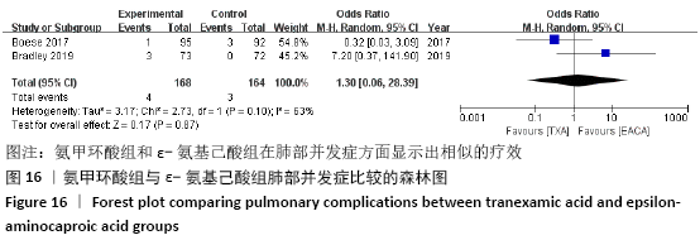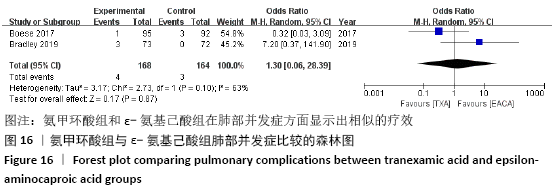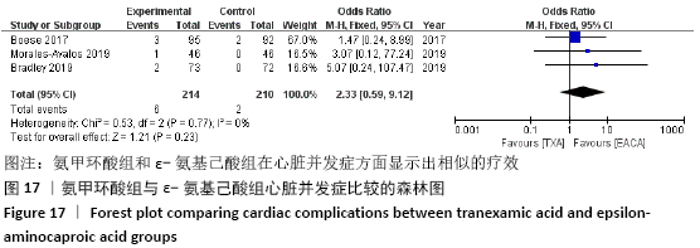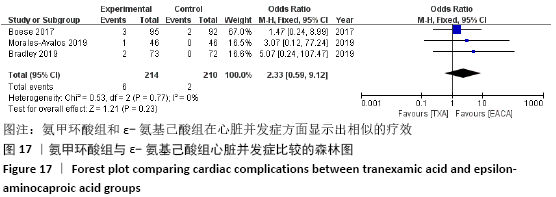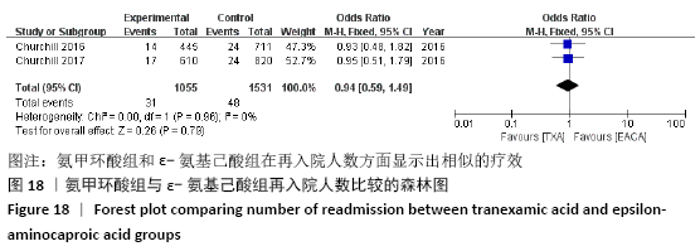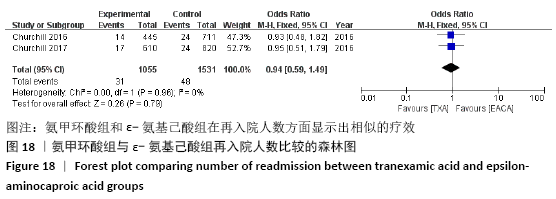Chinese Journal of Tissue Engineering Research ›› 2021, Vol. 25 ›› Issue (15): 2430-2436.doi: 10.3969/j.issn.2095-4344.3821
Previous Articles Next Articles
Efficacy and safety of tranexamic acid and epsilon-aminocaproic acid in reducing perioperative blood loss during total knee arthroplasty: a meta-analysis
Chen Wang, Feng Shuo, Zhang Yu, Chen Xiangyang
- The Affiliated Hospital of Xuzhou Medical University, Xuzhou 221002, Jiangsu Province, China
-
Received:2020-06-28Revised:2020-07-03Accepted:2020-07-31Online:2021-05-28Published:2021-01-05 -
Contact:Chen Xiangyang, MD, Chief physician, Associate professor, Master’s supervisor, The Affiliated Hospital of Xuzhou Medical University, Xuzhou 221002, Jiangsu Province, China -
About author:Chen Wang, Master candidate, The Affiliated Hospital of Xuzhou Medical University, Xuzhou 221002, Jiangsu Province, China
CLC Number:
Cite this article
Chen Wang, Feng Shuo, Zhang Yu, Chen Xiangyang. Efficacy and safety of tranexamic acid and epsilon-aminocaproic acid in reducing perioperative blood loss during total knee arthroplasty: a meta-analysis [J]. Chinese Journal of Tissue Engineering Research, 2021, 25(15): 2430-2436.
share this article
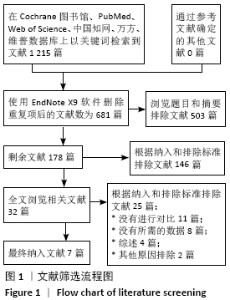
2.1 文献检索结果及质量评价 从6个电子数据库(Cochrane图书馆、PubMed、Web of Science、中国知网、万方、维普)中提取了相关文献1 215篇。使用Endnote X9软件删除重复项后,还剩下681篇;阅读题目和摘要进行初筛,排除了503篇不相关的文献;剩余178篇,根据纳入和排除标准排除文献146篇;仔细阅读其余的32篇文章,通过浏览文献中的参考文献,纳入了0个其他的研究;由于以下原因排除了另外25篇文章:没有进行对比(n=11),没有需要的数据(n=8),综述(n=4),其他(n=2)。最后1990年至2020年6月之间发表的7项研究符合纳入标准[9-15],纳入荟萃分析。详细的文献筛选过程见图1。表1详细列出了纳入文献的一般特征。 "
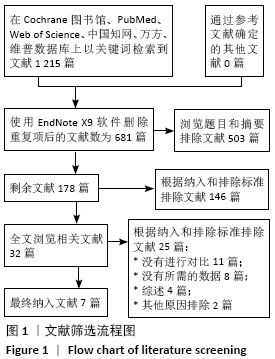
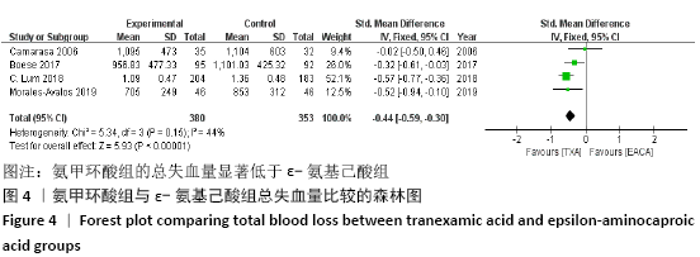
4项随机对照试验研究均描述了随机序列的产生和分配隐瞒,均描述了双盲;文献中对失访和报告等偏倚进行了详细的报道,并将其归类为低风险偏倚;对测量和其他偏倚描述的较差。3项队列研究的文献质量采用纽卡斯尔-渥太华量表进行评价,结果显示非随机对照试验偏倚风险相对较低。 2.2 Meta分析结果 2.2.1 总失血量 4项研究(共733例患者)比较了两种药物使用后的总失血量[9,12-13,15],森林图显示两者差异无统计学异质性(I2=44%,P=0.15),采用固定效应模型。结果证明两种药物之间差异有显著性意义,氨甲环酸组的总失血量少于ε-氨基己酸组(WMD=-0.44,95%CI:-0.59至-0.30,P < 0.000 01),见图4。 "
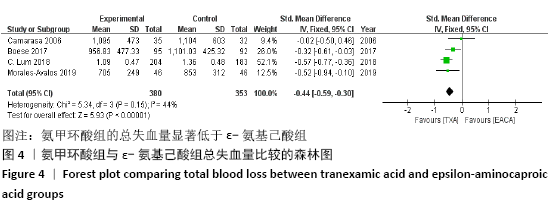
| [1] SCULCO TP. Global blood management in orthopaedic surgery. Clin Orthop Relat Res. 1998;357:43-49. [2] CARDONE D, KLEIN AA. Perioperative blood conservation. Eur J Anaesthesiol. 2009;26(9):722-729. [3] BLAINE KP, PRESS C, LAU K, et al. Comparative effectiveness of epsilon-aminocaproic acid and tranexamic acid on postoperative bleeding following cardiac surgery during a national medication shortage. J Clin Anesth. 2016;35:516-523. [4] ZUFFEREY P, MERQUIOL F, LAPORTE S, et al. Do antifibrinolytic reduce allogeneic blood transfusion in orthopaedic surgery? Anaesthesiology. 2006; 105:1034-1046. [5] HARLEY BJ, BEAUPRE LA, JONES CA, et al. The effect of epsilon aminocaproic acid on blood loss in patients who undergo primary total hip replacement: a pilot study. Can J Surg. 2002;45:185-190. [6] CHAUHAN S, GHARDE P, BISOI A, et al. A comparison of aminocaproic acid and tranexamic acid in adult cardiac surgery. Ann Card Anaesth. 2004;7:40-43. [7] MOHER D, LIBERATI A, TETZLAFF J, et al. Preferred reporting items for systematic reviews and meta-analyses: the PRISMA statement. J Clin Epidemiol. 2009;10:1006-1012. [8] HOZO SP, DJULBEGOVIC B, HOZO I. Estimating the mean and variance from the median, range, and the size of a sample. BMC Med Res Methodol. 2005;5(1):1-10. [9] CAMARASA MA, OLLÉ G, SERRA-PRAT M, et al. Efficacy of aminocaproic, tranexamic acids in the control of bleeding during total knee replacement: a randomized clinical trial. Br J Anaesth. 2006; 96(5):576-582. [10] CHURCHILL JL, PUCA KE, MEYER ES, et al. Comparison of ε-aminocaproic acid and tranexamic acid in reducing postoperative transfusions in total hip arthroplasty. J Arthroplasty. 2016;31(12):2795-2799. [11] CHURCHILL JL, PUCA KE, MEYER E, et al. Comparing ε-Aminocaproic Acid and Tranexamic Acid in Reducing Postoperative Transfusions in Total Knee Arthroplasty. J Knee Surg. 2017;30(5):460-466. [12] BOESE CK, CENTENO L, WALTERS RW. Blood Conservation Using Tranexamic Acid Is Not Superior to Epsilon-Aminocaproic Acid After Total Knee Arthroplasty. J Bone Joint Surg Am. 2017; 99(19):1621-1628. [13] LUM ZC, MANOUKIAN MAC, PACHECO CS, et al. Intravenous tranexamic acid versus topical aminocaproic acid: which method has the least blood loss and transfusion rates? J Am Acad Orthop Surg Glob Res Rev. 2018;2(11):e072. [14] BRADLEY KE, RYAN SP, PENROSE CT, et al. Tranexamic acid or epsilon-aminocaproic acid in total joint arthroplasty? A randomized controlled trial. Bone Joint J. 2019;101-B:1093-1099. [15] MORALES-AVALOS R, RAMOS-MORALES T, ESPINOZA-GALINDO AM, et al. First Comparative Study of the Effectiveness of the Use of Tranexamic Acid Against ε-Aminocapróic Acid via the Oral Route for the Reduction of Postoperative Bleeding in TKA: A Clinical Trial. J Knee Surg. 2019.doi: 10.1055/s-0039-1696722. [16] DHAWAN R, RAJGOR H, YARLAGADDA R, et al. Enhanced recovery protocol and hidden blood loss in patients undergoing total knee arthroplasty. Indian J Orthopaed. 2017;51:182-186. [17] WANG H, SHEN B, ZENG Y. Blood loss and transfusion after topical tranexamic acid administration in primary total knee arthroplasty. Orthopedics. 2015;38:e1007-1016 [18] CARSON JL, TRIULZI DJ, NESS PM, et al. Indications for and adverse effects of red-cell transfusion. N Engl J Med. 2017;377(13):1261-1272. [19] Tranexamic acid. Lexi-Drugs. Lexicomp. Wolters Kluwer Health Inc. Hudson OH. http://online.lexi.com. Accessed 14 Dec 2015. [20] HOBBS JC, WELSBY IJ, GREEN CL, et al. Epsilon aminocaproic acid to reduce blood loss and transfusion after total hip and Total knee arthroplasty. J Arthroplasty. 2018;33(1):55-60. [21] LI YJ, XU BS, BAI SP, et al. The efficacy of intravenous aminocaproic acid in primary total hip and knee arthroplasty: a meta-analysis. J Orthop Surg Res. 2018;13(1):89. [22] HUANG F, WU Y, YIN Z, et al. A systematic review and metaanalysis of the use of antifibrinolytic agents in total hip arthroplasty. Hip Int. 2015; 25:502-509. [23] KAGOMA YK, CROWTHER MA, DOUKETIS J, et al. Use of antifibrinolytic therapy to reduce transfusion in patients undergoing orthopaedic surgery: a systematic review of randomized trials. Throm Res. 2009;123:687-696. [24] RIAZ O, AQIL A, ASMAR S. Epsilon-aminocaproic acid versus tranexamic acid in total knee arthroplasty: a meta-analysis study. J Orthop Traumatol. 2019;20(1):28. [25] LIU QL, GENG PS, SHI LY. Tranexamic acid versus aminocaproic acid for blood management after total knee and total hip arthroplasty: A systematic review and meta-analysis. Int J Surg. 2018;54(Pt A): 105-112. |
| [1] | Hu Kai, Qiao Xiaohong, Zhang Yonghong, Wang Dong, Qin Sihe. Treatment of displaced intra-articular calcaneal fractures with cannulated screws and plates: a meta-analysis of 15 randomized controlled trials [J]. Chinese Journal of Tissue Engineering Research, 2021, 25(9): 1465-1470. |
| [2] | Huang Dengcheng, Wang Zhike, Cao Xuewei. Comparison of the short-term efficacy of extracorporeal shock wave therapy for middle-aged and elderly knee osteoarthritis: a meta-analysis [J]. Chinese Journal of Tissue Engineering Research, 2021, 25(9): 1471-1476. |
| [3] | Xu Feng, Kang Hui, Wei Tanjun, Xi Jintao. Biomechanical analysis of different fixation methods of pedicle screws for thoracolumbar fracture [J]. Chinese Journal of Tissue Engineering Research, 2021, 25(9): 1313-1317. |
| [4] | Jiang Yong, Luo Yi, Ding Yongli, Zhou Yong, Min Li, Tang Fan, Zhang Wenli, Duan Hong, Tu Chongqi. Von Mises stress on the influence of pelvic stability by precise sacral resection and clinical validation [J]. Chinese Journal of Tissue Engineering Research, 2021, 25(9): 1318-1323. |
| [5] | Zhang Tongtong, Wang Zhonghua, Wen Jie, Song Yuxin, Liu Lin. Application of three-dimensional printing model in surgical resection and reconstruction of cervical tumor [J]. Chinese Journal of Tissue Engineering Research, 2021, 25(9): 1335-1339. |
| [6] | Zhang Yu, Tian Shaoqi, Zeng Guobo, Hu Chuan. Risk factors for myocardial infarction following primary total joint arthroplasty [J]. Chinese Journal of Tissue Engineering Research, 2021, 25(9): 1340-1345. |
| [7] | Li Dadi, Zhu Liang, Zheng Li, Zhao Fengchao. Correlation of total knee arthroplasty efficacy with satisfaction and personality characteristics [J]. Chinese Journal of Tissue Engineering Research, 2021, 25(9): 1346-1350. |
| [8] | Wei Wei, Li Jian, Huang Linhai, Lan Mindong, Lu Xianwei, Huang Shaodong. Factors affecting fall fear in the first movement of elderly patients after total knee or hip arthroplasty [J]. Chinese Journal of Tissue Engineering Research, 2021, 25(9): 1351-1355. |
| [9] | Wang Jinjun, Deng Zengfa, Liu Kang, He Zhiyong, Yu Xinping, Liang Jianji, Li Chen, Guo Zhouyang. Hemostatic effect and safety of intravenous drip of tranexamic acid combined with topical application of cocktail containing tranexamic acid in total knee arthroplasty [J]. Chinese Journal of Tissue Engineering Research, 2021, 25(9): 1356-1361. |
| [10] | Xiao Guoqing, Liu Xuanze, Yan Yuhao, Zhong Xihong. Influencing factors of knee flexion limitation after total knee arthroplasty with posterior stabilized prostheses [J]. Chinese Journal of Tissue Engineering Research, 2021, 25(9): 1362-1367. |
| [11] | Huang Zexiao, Yang Mei, Lin Shiwei, He Heyu. Correlation between the level of serum n-3 polyunsaturated fatty acids and quadriceps weakness in the early stage after total knee arthroplasty [J]. Chinese Journal of Tissue Engineering Research, 2021, 25(9): 1375-1380. |
| [12] | Zhang Chong, Liu Zhiang, Yao Shuaihui, Gao Junsheng, Jiang Yan, Zhang Lu. Safety and effectiveness of topical application of tranexamic acid to reduce drainage of elderly femoral neck fractures after total hip arthroplasty [J]. Chinese Journal of Tissue Engineering Research, 2021, 25(9): 1381-1386. |
| [13] | Wang Haiying, Lü Bing, Li Hui, Wang Shunyi. Posterior lumbar interbody fusion for degenerative lumbar spondylolisthesis: prediction of functional prognosis of patients based on spinopelvic parameters [J]. Chinese Journal of Tissue Engineering Research, 2021, 25(9): 1393-1397. |
| [14] | Lü Zhen, Bai Jinzhu. A prospective study on the application of staged lumbar motion chain rehabilitation based on McKenzie’s technique after lumbar percutaneous transforaminal endoscopic discectomy [J]. Chinese Journal of Tissue Engineering Research, 2021, 25(9): 1398-1403. |
| [15] | Chen Xinmin, Li Wenbiao, Xiong Kaikai, Xiong Xiaoyan, Zheng Liqin, Li Musheng, Zheng Yongze, Lin Ziling. Type A3.3 femoral intertrochanteric fracture with augmented proximal femoral nail anti-rotation in the elderly: finite element analysis of the optimal amount of bone cement [J]. Chinese Journal of Tissue Engineering Research, 2021, 25(9): 1404-1409. |
| Viewed | ||||||||||||||||||||||||||||||||||||||||||||||||||
|
Full text 206
|
|
|||||||||||||||||||||||||||||||||||||||||||||||||
|
Abstract 416
|
|
|||||||||||||||||||||||||||||||||||||||||||||||||


